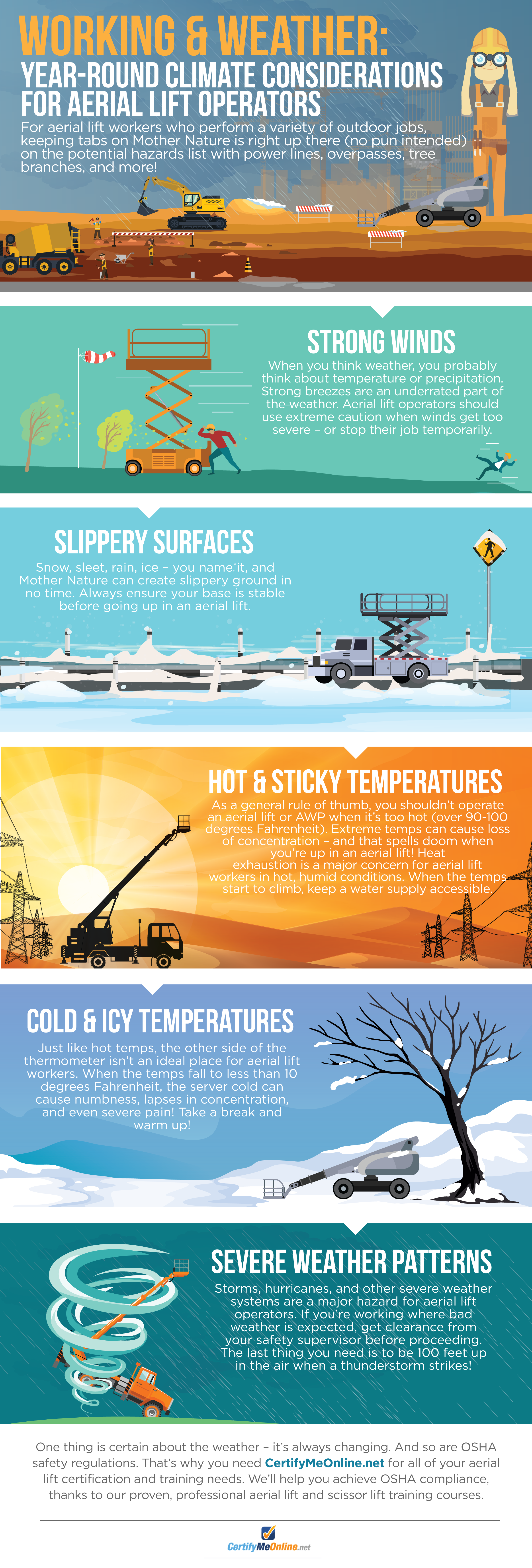OSHA Severe Weather Guidelines for Lift Operators

Why OSHA Weather Guidelines Matter
The Occupational Health and Safety Administration’s mission is to create safer work environments for Americans. While we typically think about OSHA is regards to their frequent inspections and certification requirements, they also work to educate and inform businesses about potential risks. OSHA’s severe weather guidelines can make all the difference in keeping workers safe on the job.
For instance, aerial lifts can be risky in high winds or weather that impairs workers’ vision. Once in the air, aerial and scissor lifts can become unstable and tip over. That’s why OSHA has created limits to the type of weather aerial lifts can work in. The #1 goal is always to keep workers away from harm.
Severe weather can make it unsafe for workers to work or travel. At those times, some employers granted workers paid “climate leave”. This is a good practice for outdoor workers who deal with heavy equipment and fall hazards. According to OSHA weather guidelines, workers can’t be forced to man their jobs in unsafe weather. To do so goes against OSHA cold weather regulations. It also puts workers’ lives at risk.
OSHA Rules for Inclement Weather
There are some things to remember from OSHA when working in different types of weather. To get ready for severe weather, start with being aware of the forecast. Check both short-term and long-term predictions for the area you will be working in. This way, you can take measures to prevent any accidents before they happen. With the forecast in mind, you can make adjustments according to OSHA rules and regulations.
OSHA Cold Weather Guidelines
Cold weather puts aerial lift operators at risk of hypothermia, frostbite, and other health problems. OSHA cold weather guidelines include:
- Encourage workers to wear hats, gloves, and other warm clothing and accessories
- Schedule workers to complete tasks outdoors during the warmest part of the day
- Let employees work in pairs to limit each worker’s time outdoors
- Schedule maintenance and repair jobs for warm months
- Schedule jobs for warm parts of the day
- Limit exposure to extremely cold temperatures
- Provide warm areas where workers can take breaks throughout the day
- Keep employees up to date about cold weather dangers as well. In doing so, workers will be well-equipped to watch for cold weather dangers and protect themselves and others against them
How to Recognize and Treat Cold Injuries
Cold injuries occur when the skin and underlying tissue are exposed to extreme cold, typically below 50 degrees Fahrenheit. The most common type of cold injury is frostbite, which happens when the skin and tissue freezes. Other types of cold injuries include chilblains (inflamed skin caused by repeated exposure to cold) and non-freezing cold injuries (tissue damage caused by exposure to cold without freezing).
Signs and Symptoms of Cold Injuries
The signs and symptoms of a cold injury depend on the type of injury. However, there are some general signs and symptoms that all cold injuries have in common. These include red or pale skin, numbness, tingling, or pain in the affected area.
Cold injuries are serious health concerns that should not be taken lightly. If you think you may have a cold injury, it’s important to seek medical help right away. Treatment options vary depending on the type of injury but may include rewarming the affected area slowly, treating underlying conditions, giving pain medication, and/or recommending over-the-counter creams or ointments.


OSHA Hot Weather Guidelines
OSHA encourages businesses to use the “heat index” to protect outdoor workers in hot weather. The index accounts for humidity and temperature and how they affect the safety of outdoor workers. By studying this index, an employer can take appropriate measures to safeguard its outdoor workers against heat-related illnesses. OSHA weather guidelines for hot days include:
- Avoid using AWP and aerial lifts when temperatures reach the 90s or above
- Keep a water supply close to the work site on hot days
- Workers should consistently drink cool water throughout the day even if they’re not thirsty
- Ease workers into the hot environment, allowing them to build a tolerance to the heat over the course of a week
- Breaks in shaded areas are necessary for proper rest and recovery throughout the day
- Hats and other hot weather attire are recommended to keep workers’ internal body temperatures in a safe place
- Verbally check in with employees to look for signs of heat exhaustion or heat stroke
Heat-Related Injuries
There are three main types of heat-related injuries that you should be aware of: heat cramps, heat exhaustion, and heat stroke. Heat cramps are muscle pains or spasms that usually occur in the legs or abdomen. They are caused by excessive sweating and loss of electrolytes. Heat exhaustion is characterized by heavy sweating, weak pulse, nausea, dizziness, and tiredness. It is caused by the body’s inability to cool itself down and can lead to shock and even death if left untreated. Heat stroke is the most serious type of heat-related injury and occurs when the body is unable to regulate its own temperature. Symptoms include high body temperature (103 degrees Fahrenheit or higher), red, hot skin that is dry or damp, rapid pulse, headache, dizziness, and nausea. If you suspect someone has a heat stroke, call 911 immediately as this is a medical emergency.
OSHA Rain Regulations
There are no specific guidelines from OSHA regarding rainy inclement weather construction. However, employers are always responsible for maintaining safe, healthy work environments. If a worker believes a rainy work environment is unsafe, they have the right to refuse dangerous work.
When it comes to rain or any other inclement weather conditions, it is always better to err on the side of caution. Harsh weather conditions should not hamper a worker’s ability to safely complete tasks outdoors. Otherwise, if workers are forced to work in poor weather conditions, they could put themselves or others at risk of accidents or injuries.
Tips to Protect Aerial Lift Workers in Severe Weather Conditions
If your area is anticipating severe weather, take action to protect workers from accidents and injuries. OSHA’s severe weather guidelines are just the beginning. Here are a few practical ways to protect workers from:
Strong winds
Aerial lift workers should use extreme caution when winds get too severe. Or they should stop working until the winds die down. Keep in mind that wind measured at ground level is often less severe than when measured at the height most AWP workers will be at. When in doubt, keep workers on the ground until the winds have died down.
Slippery Surfaces
Snow, sleet, rain, ice – you name it and Mother Nature can create slippery ground in no time. Always ensure your base is stable before going up in a lift. Keep an eye on conditions throughout the day, too. What might have been stable at the start of the work day might no longer be as solid a foundation for AWP workers by noon.
Hot Temperatures
Don’t operate an aerial lift when it is 90 degrees or hotter. Extreme temps can cause loss of focus on the job. That spells doom when you’re up in an aerial lift! Heat exhaustion is a major concern for lift workers in hot, humid weather. When the temps start to climb, keep a water supply within reach.
Severe Weather Patterns
Storms, hurricanes, and other severe weather systems are major hazards for lift workers. If bad weather is expected, get clearance from your safety supervisor before starting a job. The last thing you need is to be 100 feet up in the air when lightning and thunder strike!
Help Aerial Lift Operators Work Safely in All Weather
Following OSHA weather guidelines is a great way to keep workers safe, no matter what the forecast has in store. Ongoing training is crucial for aerial lift operators as well, as it keeps workers up to date about weather-related jobsite dangers. That way, aerial lift operators can avoid weather-related accidents. At the same time, businesses can do their part to protect their aerial lift operators against severe weather conditions.
Businesses are responsible for providing their workers with safe and healthy work environments. Failure to do so puts employees in danger and can lead to OSHA penalties and fines. If your business employs aerial lift operators, you should provide training that teaches them how to safely perform tasks in various weather conditions.
CertifyMeOnline.net offers an aerial lift training program that teaches workers about all aspects of lift safety. Upon completion, workers can earn aerial lift safety training certification that verifies they know how to safely use a lift in myriad weather conditions. For more information about our program, please contact us online or call us today at (602) 277-0615.
